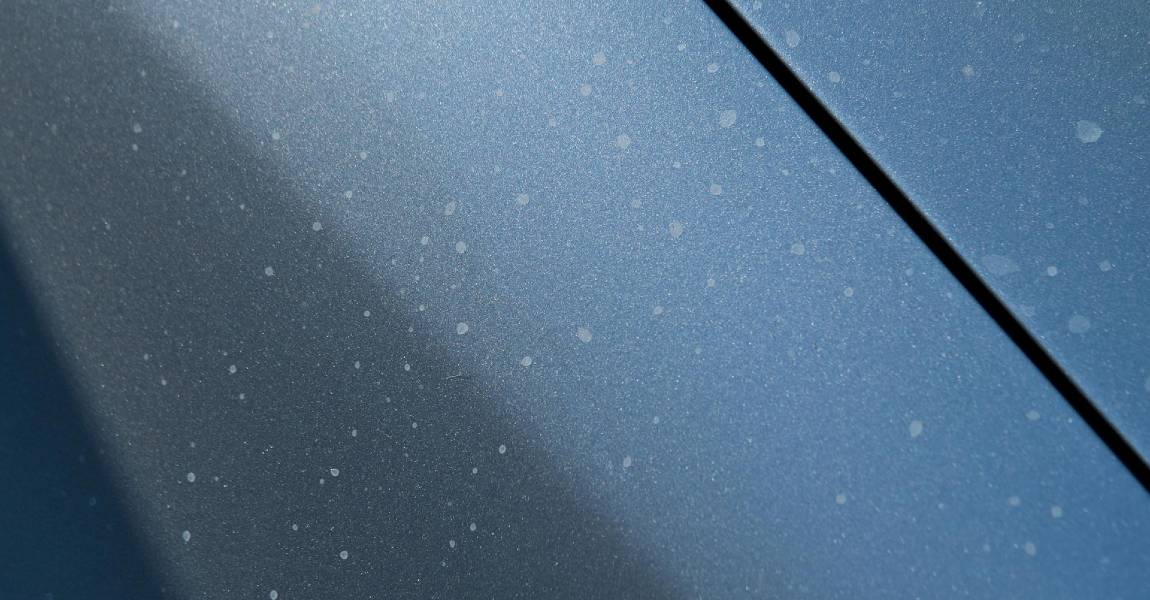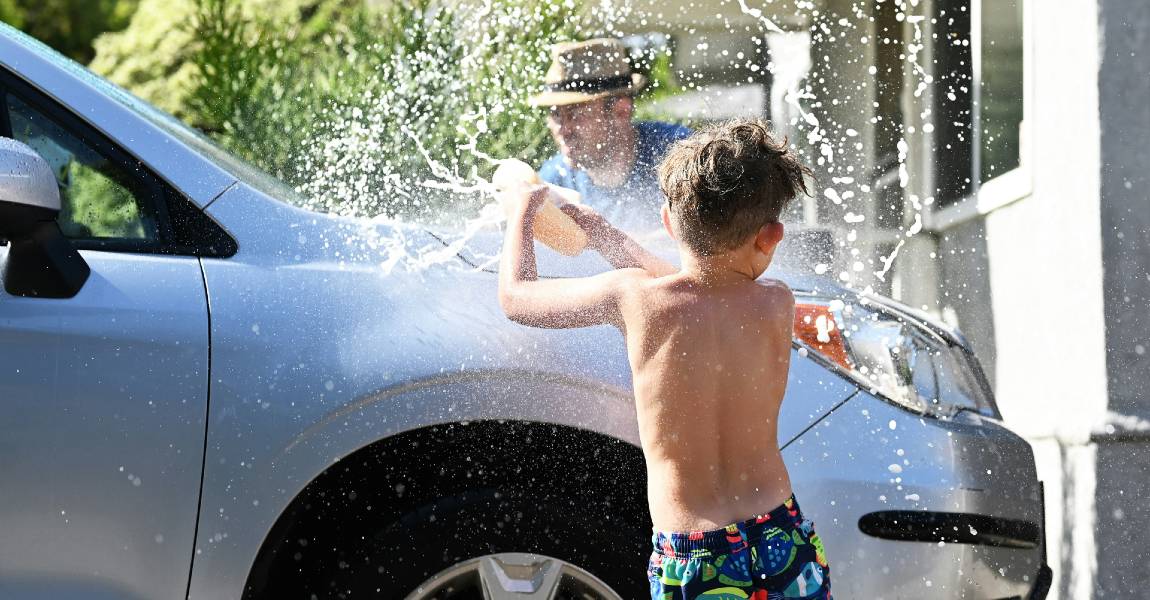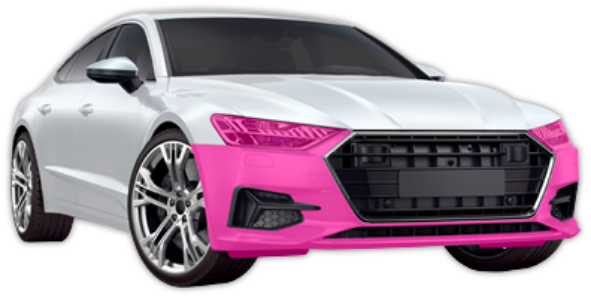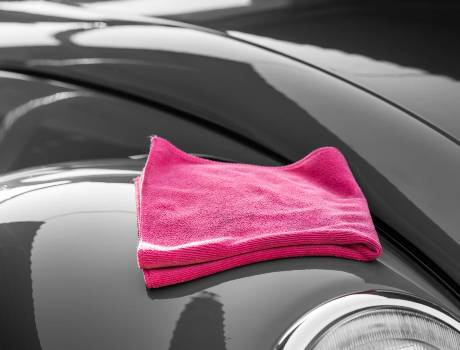As springtime rejuvenates the world around us, it brings with it not just the blossoming of flowers but also the challenge of maintaining the perfect sheen on our vehicles. We all relish the glossy look of a freshly washed car, but have you ever noticed those persistent, cloudy blemishes that mar its surface? Water spots – the nemesis of car enthusiasts everywhere, especially on vehicles with ceramic coatings.
Learn how to Remove Water Spots on Ceramic Coating. Fear not, we’re here to help you master the art of ceramic coating care, offer the most effective DIY water spot removal techniques, and provide you with valuable knowledge on water spot prevention. Keep your car’s ceramic coating looking like it just rolled off the showroom floor with our expert guidance this spring. To learn more read our guide How To Protect Your Car This Spring with a Ceramic Coating

Key Takeaways – Remove Water Spots on Ceramic Coating
- Identifying the source of water spots on ceramic coatings can save your car’s aesthetic appeal and its protective layer.
- With the right guidance, DIY water spot removal techniques can be both straightforward and effective.
- Advanced knowledge in ceramic coating care is crucial for sustaining your vehicle’s immaculate appearance.
- Implementing water spot prevention strategies now can minimize the need for repairs and maintenance later.
- Spring is the perfect time to refresh your approach to preserving your vehicle’s high-quality finish.
Table of Contents – Remove Water Spots on Ceramic Coating
Understanding Water Spots on Ceramic Coatings
When it comes to ceramic coating maintenance, the initial step is recognizing the challenge posed by water spots. These tricky residues are not just a common nuisance but can affect the long-term integrity and appearance of your car’s coating. Let’s delve deeper into the science behind water spots, their various types, and the best way to remove water spots without damaging your vehicle’s protective layer.
Types of Water Spots
Essentially, water spots are categorized based on their source and the complexity of removal. The first kind, commonly known as Type I, are superficial spots caused by the simple evaporation of water on the surface of your car. These can typically be addressed with basic washing and drying techniques. Type II spots originate from more mineral-rich water sources, leading to deposits that may require specialized cleaners for removal.
Why They Form on Ceramic Coatings
Water spots are particularly problematic on ceramic coatings due to the coating’s inherent properties. While ceramic coatings excel at repelling water, the minerals in the water itself are not always washed away, leaving behind visible traces once the water evaporates. This issue is exacerbated by environmental factors and the quality of water used during washes.
Impact on Vehicle Aesthetics and Protection
While superficial water spots rarely cause permanent damage, they can detract significantly from the glossy and pristine appearance of a ceramic-coated car. More importantly, if left unattended, harder mineral deposits can etch into the coating, potentially weakening its protective properties. Understanding the impact of these water spots is crucial for effective ceramic coating maintenance.
| Water Spot Type | Source | Removal Difficulty | Impact on Coating |
|---|---|---|---|
| Type I (Superficial) | Evaporated clean water | Low | Minimal |
| Type II (Mineral-rich) | Hard water, environmental factors | High | Potential etching |
Essentials for Water Spot Removal from Ceramic Coatings
Ensuring your vehicle’s aesthetic and durable finish involves more than just occasional cleaning. When it comes to maintaining ceramic coatings, knowing how to remove water spots on ceramic coating is key to keeping the surface pristine. We will guide you through the essential tools and materials needed, along with advice on selecting the right products to maintain the quality of your ceramic coating.
Tools and Materials You’ll Need
Begin with gathering the right tools to avoid any damage while removing water spots. Here’s what you’ll need:
- High-quality microfiber towels that can gently clean without scratching the coated surface.
- Ph-neutral water spot removal specifically designed for use on ceramic coatings to ensure there’s no degradation of the coating.
- Soft sponges or foam applicators for applying cleaners gently.
- Distilled water to ensure no further water spots are caused during the cleaning process.
These items collectively form a safe and effective toolkit for any ceramic coating care routine.
Selecting the Right Products for Your Coating
Selecting appropriate cleaning products is crucial for maintaining the integrity of your ceramic coating while effectively removing water spots. Opt for cleaners that are formulated for ceramic coatings, as these will provide protection without causing harm to the coating. Always ensure the compatibility of the product with your specific type of ceramic coating before application.
Here’s a comparative look at some popular water spot removal solutions:
| Product Name | Type | Suitability for Ceramic Coating | Additional Features |
|---|---|---|---|
| CeramiClean Water Spot Remover | Spray | Yes | Includes UV protectant |
| EcoShine Spotless | Gel | Yes | Environmentally Friendly |
| SpotGone Rinse Agent | Liquid | Yes | Fast Acting Formula |
Incorporating these water spot removal tips into your regular vehicle care routine will not only enhance the appearance of your car but also prolong the life of its ceramic coating. Each product has its unique benefits, so choosing the one that best fits your needs and the specifics of your ceramic protective layer is essential for optimal care and maintenance.
Pre-Wash Techniques to Prevent Water Spots
In our quest for flawless vehicle care, we understand the challenges of removing water spots from cars and the importance of preventive measures in ceramic coating maintenance. Before diving into the more detailed practices, let’s explore some effective pre-wash techniques that can significantly enhance water spot prevention on your vehicle.
Mineral deposits from hard water are a primary contributor to water spots, which can detract from your vehicle’s appearance and compromise its protective ceramic coating. Employing pre-wash strategies such as using soft water for rinsing can help mitigate these effects. Not only does soft water prevent the buildup of minerals, but it also enhances the overall effectiveness of your washing regimen.
Soft Water Rinse – Why It Matters
Soft water is crucial in the fight against water spots. Its low mineral content ensures that fewer deposits are left on the surface of your vehicle after rinsing. This practice not only guards against the aesthetics of water spots but also contributes to the longevity and efficacy of the ceramic coating. By using soft water, you ensure that the surface remains spotless and reflective, maintaining the pristine condition of your vehicle.
Using Filtered Water for Your Vehicle
Another significant step in ceramic coating maintenance is the use of filtered water during car washes. Filtering out impurities and minerals before they reach your vehicle’s surface can greatly decrease the likelihood of water spots forming. This method is especially beneficial for those living in areas with hard water. Regular use of filtered water in car care routines can lead to a visibly clearer and more protected surface, thereby extending the life of your vehicle’s ceramic coating.
Implementing these techniques not only simplifies the process of removing water spots from cars but also enhances overall ceramic coating maintenance. By addressing water quality before it interacts with your vehicle’s surface, you lay the foundation for a cleaner, spot-free finish.
How to Remove Water Spots on Ceramic Coating
When faced with the challenge of how to remove water spots on ceramic coating, knowing the best way to remove water spots is crucial to maintaining your vehicle’s pristine condition. We advocate for a method that combines effectiveness with care to avoid damaging your ceramic coating. Here’s a straightforward overview to help you in water spot removal.
- Light spots can often be treated with a simple vinegar solution.
- More persistent spots might require a specialized water spot removal product designed for ceramic coatings.
Before proceeding with the removal process, it’s important to wash your vehicle thoroughly to eliminate any loose dirt and debris that could scratch the coating during the spot removal phase. Always use gentle, circular motions to apply any product and rinse with clean, filtered water afterward.
Preventative measures are as vital as corrective ones. Regular maintenance and proper drying techniques post-wash can reduce the occurrence of water spots, securing the aesthetic appeal of your vehicle. Remember, the condition of your vehicle reflects the care you put into it—regular upkeep not only enhances appearance but also preserves the integrity of the ceramic coating for years to come.
Detailed Step-by-Step Guide for Water Spot Removal
Embarking on the journey of DIY water spot removal can seem daunting, but with our clear, step-by-step guidance, you’ll find it surprisingly manageable. This tutorial is tailored especially for those with ceramic coatings, focusing on the best way to remove water spots while maintaining optimal ceramic coating care.
Cleaning the Surface: The first step requires you to thoroughly clean the surface. This removes any dust, dirt, and grime that can interfere with the effectiveness of the water spot remover. It’s vital to use a mild soap and soft cloth to avoid scratching the coating.
Applying Water Spot Remover: Once the surface is clean, apply a high-quality water spot remover designed for ceramic coatings. Spread it evenly using a microfiber towel, working in small sections to ensure comprehensive coverage without missing any spots.
Rinsing and Drying Techniques: After the remover has been allowed to sit for the recommended time, rinse the area thoroughly with clean water. It’s best to use deionized water to avoid new water spots. Dry the surface with a clean, soft towel or a squeegee to prevent mineral deposits from settling back on the surface.
Following these steps will help you achieve a spotless finish on your ceramic-coated vehicle, ensuring long-lasting protection and shine. Remember, routine maintenance is key in extending the life of the coating and keeping your vehicle looking its best.
DIY Water Spot Removal Tips
For those who love a hands-on approach to maintaining their vehicle’s shine, DIY water spot removal can be both satisfying and effective. With a few simple ingredients and the right techniques, you can ensure your vehicle’s ceramic coating remains impeccable. Let’s explore some homemade solutions and essential safety measures to maintain your ceramic coating’s integrity.
Homemade Solutions for Mild Spots
- Vinegar Solution: Mix equal parts of white vinegar and distilled water. Apply with a soft cloth, gently rubbing on the spots.
- Lemon Juice Mix: Combine lemon juice with distilled water for a natural acidic cleaner that breaks down water spots without harsh chemicals.
- Baking Soda Paste: Create a paste with baking soda and a small amount of water. Apply gently with a sponge, then rinse thoroughly with clean water.
Safety Measures to Avoid Damaging the Coating
- Always test any DIY solution on a small, inconspicuous area of your vehicle first to ensure it doesn’t harm the ceramic coating.
- Do not use abrasive materials like steel wool, which can scratch and degrade the ceramic surface.
- Ensure thorough rinsing after applying cleaning solutions; residual chemicals can damage the coating if left to dry.
- Maintain a routine of ceramic coating maintenance after each cleaning to restore protective properties and enhance shine.

By adhering to these water spot removal tips and focusing on proactive ceramic coating maintenance, you can efficiently tackle the problem of water spots and preserve the longevity and aesthetics of your vehicle’s surface. Just remember, while DIY methods are excellent for mild cases, tougher stains might require professional-grade products and techniques.
Professional Methods for Stubborn Water Spot Removal
At times, removing water spots from your car, particularly when protected by ceramic coatings, requires more advanced solutions than those provided by standard DIY methods. Professional water spot removal services offer specialized treatments that cater specifically to ceramic coating care, ensuring both effectiveness and safety.
When to Seek Professional Help
Identifying the right moment to call in the experts can save you both time and the risk of damaging your car’s coating. It is advisable to seek professional help if:
- The water spots have not responded to regular cleaning efforts.
- The spots appear etched or bonded too deeply into the ceramic coating.
- You’ve applied aggressive DIY methods without success.
- There is a significant area covered with hard mineral deposits.
Services Offered by Professionals
Professional detailing services employ a variety of advanced techniques to ensure comprehensive care and maintenance of your vehicle’s ceramic coating while effectively removing even the most persistent water spots. Here are some of the typical services provided:
- Deep cleaning and decontamination that prep the surface for treatment.
- Application of potent but safe chemical removers tailored to ceramic coatings.
- High-grade mechanical polishing to meticulously clear out any residues.
- Protective finish application to enhance the coating’s resistance to further water spot formation.
Choosing to utilize professional services not only restores the pristine look of your vehicle but also plays an integral role in the long-term maintenance and care of its ceramic coating.
Ceramic Coating Maintenance to Prevent Future Water Spots
To ensure your vehicle remains pristine and protected, effective ceramic coating maintenance is crucial. Not only does this help in water spot prevention, it also enhances the longevity and efficacy of the ceramic coating itself. Let’s delve into some essential maintenance practices that will keep your coating in top condition.
One foundational aspect of maintaining a ceramic coat is engaging in regular washing and drying practices. It is essential to wash your vehicle every two weeks using a pH-neutral car shampoo, as this helps reduce the risk of minerals from the water forming spots on the surface. For more detailed guidance on these practices, consider consulting resources on how to remove water spots on ceramic coating.
- Wash Regularly: Regular washing not only maintains the aesthetic appeal of your vehicle but also prevents contaminants from bonding with the ceramic coating. Using filtered or distilled water can be particularly effective in minimizing the presence of hard minerals that cause spotting.
- Dry Thoroughly: After washing, it’s crucial to dry your vehicle thoroughly. Leaving it to air dry can result in water spots, especially if the water is hard or contains a high mineral content.
Moreover, periodic coating rejuvenation is an excellent way to maintain the coating’s integrity and effectiveness. This process typically involves applying a suitable ceramic boost product that reinforces the coating’s hydrophobic properties, thus enhancing its ability to repel water and dirt.
- Use Quality Products: Always ensure you use premium products recommended for ceramic coatings to avoid damaging the surface.
- Professional Check-ups: Regularly having a professional inspect and touch up your coating can help catch any early signs of wear and prolong the coating’s life.

In conclusion, keeping up with ceramic coating maintenance and implementing robust cleaning and rejuvenation practices are key to avoiding future water spots and maintaining the visual and protective qualities of your ceramic coating. Regular attention ensures that your vehicle not only looks great but is also well-protected over time.
Advanced Ceramic Coating Care Tips
Maintaining the pristine condition of your ceramic-coated vehicle goes beyond routine cleaning, involving specialized strategies that ensure long-term protection and shine. In this section, we delve into advanced ceramic coating care techniques, focusing on protection from hard water and enhancing the coating’s hydrophobic features.
Exposure to hard water is a common hurdle in ceramic coating care. It typically leads to the accumulation of water spots, which can detract from the aesthetic appeal of your vehicle. Therefore, figuring out the best way to remove water spots and prevent their recurrence is essential for maintaining the coating’s integrity.
Protecting Against Hard Water
Hard water containing high mineral content can cause significant spotting. To combat this, we recommend using a water softener during car washes to eliminate excess minerals from the water. Additionally, drying your vehicle immediately after washing prevents residue from settling on the surface, which is a crucial step in effective water spot removal tips.
Boosting Your Coating’s Hydrophobic Properties
Enhancing the hydrophobic properties of your ceramic coating is paramount, as it enhances the surface’s ability to repel water, thus minimizing spot formation. Regular application of a silica-based top-up spray can reinforce these hydrophobic properties, ensuring that water beads up and rolls off the surface more effectively.
The table below illustrates various products and tactics to optimize protection against hard water and boost hydrophobicity, which are pivotal in the advanced care of ceramic coatings:
| Category | Product or Tactic | Frequency of Use | Benefits |
|---|---|---|---|
| Water Softening | Inline Water Softener | Every Wash | Reduces mineral deposits, preventing water spots |
| Hydrophobic Enhancement | Silica-based Sealant Spray | Monthly | Enhances water repellency and protective barrier |
| Drying Techniques | Microfiber Towels | After each wash | Prevents mineral spot formation by drying quickly |
Incorporating these measures in your ceramic coating care routine will not only proclaim the best way to remove water spots but will also elevate the overall lifespan and effectiveness of the ceramic layer. Commitment to these advanced care tips ensures your vehicle remains both stunning and well-protected against environmental elements.
Conclusion – How To Remove Water Spots on Ceramic Coating
As we bring our thorough exploration on DIY water spot removal and ceramic coating maintenance to a close, we emphasize the critical role these practices play in preserving the glossy finish of your vehicle. By employing the right techniques for water spot prevention and addressing issues promptly, you’ll not only enhance the visual appeal of your car but also extend the life of its ceramic coating. Implementing the steps and strategies we’ve shared is key to maintaining the hydrophobic and protective qualities that are intrinsic to a well-maintained ceramic barrier.
Our journey has equipped you with a solid understanding of the tools and products vital for tackling water spots, the methodology behind a successful cleaning regimen, and the importance of regular ceramic coating maintenance. When confronted with the more tenacious water spots, remember that the expertise of Pro-Tech Auto Shield & Nano Coatings is merely a phone call away. Contact us today at 303-423-2841 for bespoke advice or to avail ourselves of our professional services.
Ultimately, consistency in your maintenance schedule and a mindful approach to care will keep water spots at bay and ensure that your vehicle remains a shining testament to the benefits of ceramic coatings. By advocating for proactive care, sharing insights on the latest DIY water spot removal methods, and underscoring the value of professional intervention when needed, we strive to empower you with the knowledge to preserve your vehicle’s immaculate condition. Our shared passion for automotive detailing and maintenance is at the heart of every piece of advice we impart, guiding you towards an immaculate, spot-free finish on your treasured ride.
FAQ – Remove Water Spots on Ceramic Coating
What types of water spots can form on ceramic coatings?
There are primarily two types of water spots that can form on ceramic coatings: Type I, which are mineral deposits left behind by evaporated water, and Type II, which are more stubborn and result from water etching into the coating.
Why are water spots particularly noticeable on ceramic coatings?
Water spots are noticeable on ceramic coatings because they can disrupt the uniform, glossy finish for which the coating is known. Additionally, because ceramic coatings are designed to repel water, any residue that sticks out can be more apparent.
What impact do water spots have on vehicle aesthetics and protection?
Water spots detract from the visual appeal of a vehicle by creating unsightly marks on the surface. They can also compromise the protective qualities of a ceramic coating if left unaddressed, potentially leading to more permanent damage.
What tools and materials are needed for safe water spot removal from ceramic coatings?
To safely remove water spots from ceramic coatings, you’ll need a few key items including soft microfiber towels, a pH-neutral car shampoo, distilled water, and a commercial water spot remover that is safe for use on ceramic coatings.
How can I select the right products for my ceramic coating?
Look for cleaning and maintenance products specifically designed for ceramic coatings. These should be pH-neutral and free of harsh chemicals that can damage the coating. Always read the label to ensure compatibility with your particular type of ceramic coating.
Why does using soft water matter for preventing water spots?
Soft water contains fewer minerals than hard water, which means there is a reduced chance of leaving behind mineral deposits that can lead to water spots. Using soft water for the final rinse can prevent these deposits from forming.
What are the benefits of using filtered water on ceramic-coated vehicles?
Using filtered water helps to ensure that the water is free from contaminants and excess minerals that can cause water spots. This results in a cleaner wash and reduces the risk of spots forming as the vehicle dries.
What is the best way to remove water spots from ceramic coatings?
The best way to remove water spots from ceramic coatings is to use a gentle approach with the correct chemical solutions that are designed for ceramic coatings. This involves washing the vehicle with pH-neutral soap, applying a dedicated water spot remover, and then thoroughly rinsing and drying the vehicle.
Can I use homemade solutions to remove mild water spots?
Yes, for mild water spots, you can use homemade solutions such as a mixture of white vinegar and distilled water. However, you should test any DIY solution on a small, inconspicuous area first to ensure it does not damage the coating.
When should I seek professional help for water spot removal?
If water spots have etched into the coating or if you are not comfortable using chemical removers, it’s best to seek professional help. Professionals have access to advanced tools and techniques that can safely remove stubborn spots without harming the coating.
What kind of maintenance is necessary to prevent future water spots on ceramic coatings?
Regular washing with a pH-neutral soap, using deionized or filtered water for rinsing, and thorough drying with clean microfiber towels can help prevent water spots. Additionally, applying a ceramic coating booster periodically can reinforce its hydrophobic properties.
How can I enhance the hydrophobic properties of my ceramic coating to resist water spots?
You can enhance the hydrophobic properties of your ceramic coating by using a silica-based spray-on product designed to boost the coating’s ability to repel water. Regularly applying such products can make it easier for water to bead off the surface, thus reducing the potential for water spots.








WHAT OUR CLIENTS ARE SAYING